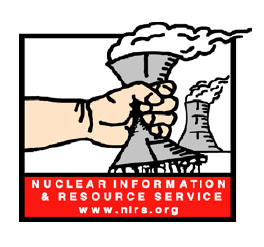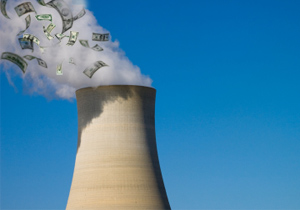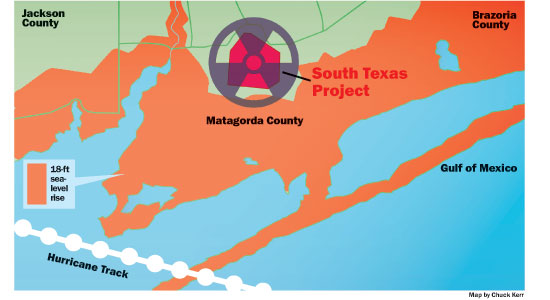Archive for the ‘Featured Articles’ Category
60 Day Clock For Nuclear Opponents Starts Ticking
60 Day Clock For Nuclear Opponents Starts Ticking;
Luminant Moves Forward Toward Expansion of Comanche Peak Nuclear Plant
Reactor Design Not Ready for Primetime

For Immediate Release
February 5, 2009
Contacts:
Karen Hadden, Director, SEED Coalition 512-797-8481
Tom “Smitty” Smith, Director, Public Citizen’s Texas Office 512-797-8468
Download press release in pdf format for printing.
AUSTIN, TX The NRC posted notice today on the federal register of the application of Luminant to build two reactors at the Comanche Peak nuclear plant site, southwest of Fort Worth. Citizens now have only 60 days to prepare and present their legal case in opposition.
The reactor design (US-APWR) has not been approved by the NRC and it has never been built anywhere in the world. Mitsubishi Heavy Industries Ltd. submitted the US-Advanced Pressurized Water Reactor (US-APWR) for design certification on December 31, 2007, but the review will take the NRC several years and is not scheduled to be completed until 2011.
“This fast-tracked combined construction and operating license process was rationalized based on the assumption that new reactors would only use pre-certified designs, but the Comanche Peak reactor design is not approved yet. Not only does this put a huge burden on the public to quickly learn what’s happening and become involved within only 60 days, but it also puts pressure on the NRC to rubberstamp designs that should have extra scrutiny,” said Smith.
“The streamlined process is designed to cut citizens out and limit public involvement in the licensing of two reactors that could cost $22 billion before cost overruns,” said Karen Hadden, executive director of the Sustainable Energy and Economic Development (SEED) Coalition. “It makes the fast-tracking of TXU’s coal plants in Texas look slow.”
Comanche Peak Unit One ran ten times over budget and was years late coming online. An untested reactor design increases the likelihood of similar problems occurring again and soaring rate hikes that would result.
“If safety was a real concern, the three processes all occurring simultaneously would be taken one at a time. This rush increases risks of safety oversight and problems from faulty design and construction” said Hadden. “Reactor designs should be analyzed first, and if and when the NRC deems them adequate, a construction license application should be allowed. If the plant has no major construction flaws after completion, then the operating license should be decided.”
This federal notice posting comes as Congress debates whether to give more subsidies to the nuclear industry in the stimulus bill. The US Senate included in its economic stimulus package a handout of $50 billion to the nuclear industry, subsidies in the form of federal loan guarantees. The House did not include these handouts which would “bail in” a fifty year old industry that still can’t stand on its own, remaining dependent on federal subsidies because investors are wary of the huge liability and risks.
The NRC today issued a Federal Register notice regarding the public’s opportunity to request participation in the hearing regarding the Comanche Peak COL. The deadline for filing a request to participate is April 6. Citizens must develop their contentions during this extremely short time period, even though major factors could change, including the design of the reactors.
The notice is online at http://edocket.access.gpo.gov/2009/pdf/E9-2455.pdf
The notice is entitled “Luminant Generation Company LLC; Application for the Comanche Peak Nuclear Power Plant Units 3 and 4; Notice of Order, Hearing, and Opportunity to Petition for Leave to Intervene.” This federal register notice was published as Volume 74, pages 6177-6180.
It posting will also be online at www.NukeFreeTexas.org, where a series of articles detailing the history of the existing Comanche Peak reactors is available.
Comanche Peak Federal Register Notice posting. 2/5/09
###
Overview of NRC licensing process
Nuclear Information and Resource Service produced a briefing paper on the NRC licensing process:

Every atomic power reactor is licensed by the federal Nuclear Regulatory Commission (NRC). By law, the licensing process is open to public participation. In reality, the process is deliberately designed to be difficult to understand and to discourage effective public involvement. Even so, a determined and knowledgeable public can affect nuclear licensing decisions. The purpose of this briefing paper is to provide a basic overview of the licensing process, as a first step toward helping grassroots groups, individuals, and state and local governments determine whether they want to participate in this process.
Exclusive analysis, Part 1: The staggering cost of new nuclear power
Climate Progress
January 5, 2009

A new study puts the generation costs for power from new nuclear plants at from 25 to 30 cents per kilowatt-hour – triple current U.S. electricity rates! This staggering price is far higher than the cost of a variety of carbon-free renewable power sources available today – and ten times the cost of energy efficiency. Read More…
Download the study:
- Business Risks and Costs of New Nuclear Power
by Craig A. Severance, January 2, 2009 - Impacts to Ratepayers
- History of Cost Overruns
- Effect of Economic Downturn
- Construction Schedules May Be Delayed
- Conclusions and Recommendations
- Texas environment and consumers’ groups point to new study saying Nuclear Power would deepen Economic Crisis Press Release 1/16/09
Download factsheets excerpted from this report:
Pushing nukes at the NRC
SA’s power plants skirt pressure test as federal regulators exempt industry from terrorism studies
By Greg Harman
San Antonio Current
November 19, 2008

Matagorda Nuclear Map
The day before Hurricane Ike roared into Galveston Island and pressed deep into the Houston Ship Channel, a surge in internet search traffic googling "STNP" washed into my humble enviro blog. "So," a smaller, less-charitable part of myself exhaled as I charted the numbers, "now they’re worried."
Employees at South Texas Nuclear Project, a 2,700-megawatt complex of twin Westinghouse reactors located 10 miles from the impetuous Gulf, were getting ready to take the plant that supplies roughly 33 percent of San Antonio’s power offline while dispatching comforting press releases to the media. Outside the plant’s perimeter, netizens were eyeballing approximate storm-surge threats thanks to a University of Arizona computer model I had embedded at harman on earth.
A press release from the recently renamed South Texas Project, a partnership of the City of San Antonio and NRG Energy, preened over the hardiness of the reactor’s bunkers, the "steel-reinforced concrete walls, four to seven feet thick, that are built to withstand Category 5 hurricanes," guarding the reactors and spent radioactive fuel stored onsite.
The actual risk to the region’s residents dodged like an apparition between the industry’s assurances, red-lining computer models, and the eye of Ike itself, a growing Cat 4 now recognized as the largest Gulf hurricane ever recorded.
It would have been the perfect time for one of the U.S. Nuclear Regulatory Commission’s focus groups to break out the folding tables and plant a circle of chairs in the sand. After all, if you want to honestly gauge public attitudes about nuclear power, meltdowns, and evacuation knowledge, as the NRC busily set about doing in 2007, the place for unvarnished truths would have been under the eye of Ike.
NRC’s survey of those living inside the 10-mile evacuation zones of nuclear power plants was released last week. Most participants "were generally well informed about what to do in a nuclear power plant emergency" and "agreed they would evacuate, shelter-in-place or monitor for more information" in a radiological "event."
The findings will no doubt be used to provide additional support for the reviving industry. However, as coastal Texans know, the best intentions often fall by the drainage canal when the evacuation sirens blow.
Stealing heavily from the NRC’s survey framework, I reimagine a "live" survey proceeding slightly differently.
Sound of sand compressing under the weight of shifting chairs. Rising winds steadily rustling the Moderator’s papers.
Moderator: Hi. My name is < NAME >. Would you like to play a game?
Focus Group (FG): (Collective pause. Bead of sweat falls.)
Moderator: Great! I am going to walk you through a made-up story about what might happen if a nuclear-plant emergency took place.
FG A: Do I need my glasses? (Glasses, unfolded, fly from hands.)
Moderator: It’s 12:30 in the afternoon. You are getting ready to have lunch. You hear warning sirens at the South Texas Nuclear Power Plant. The sirens are not normally tested during the day. How do you rate your degree of concern, if any?
FG B: What am I having for lunch?
Moderator: Great! An Emergency Alert System message is broadcast. You hear the Texas Bureau of Emergency Management has declared a GENERAL EMERGENCY at South Texas Nuclear Power Plant …
FG A: Did you go to Bay City Middle School, sweetheart?
FG B: I don’t listen to the radio.
Moderator: Great! All residents north and west of South Texas Nuclear Power Plant are ordered to evacuate. Those to the east are asked to shelter in place. Do you have, A) General knowledge about seeking shelter? B) Little knowledge of shelter? C) Gnawing concerns of unspecific origin?
FG C: Is this going to be on TV? I mean, should I fix my hair?
FG A: Will it be a long drive, dear?
Moderator: Do you know how to shelter in place?
FG B: (Crawls under foldout table, tucking head between knees. Table blows away.)
FG C: That’s for an atomic attack. We’re not being "attacked," are we?
FG A: (Pulling roll from purse) Duct tape?
Moderator: Your potassium-iodide pills aren’t where you remember leaving them. The dogs want to come inside. There is a pizza-delivery car abandoned in your driveway.
FG B: Just like in Left Behind!
FG C: Was that pre-rapture or post?
FG A: (Working sand from ear) Would I like some toast?
Moderator: Great! On behalf of the U.S. Nuclear Regulatory Commission, I’d like to thank you for participating in our survey of community attitudes and behaviors. The resurgence in interest in new nuclear power plants has only been made possible by the sustained safe and reliable performance of the current fleet of operating reactors. The nuclear industry is now, and may always remain, just one accident away from retrenchment.*
(Alarm sounds. FG A, FG B, and FG C run in three diverging directions as moderator unfolds umbrella and spins off into vortex.)
If there’s a point to the preceding 428 words of fictionalized NRC smear it would be to suggest that public attitudes about nuclear power, having risen from 28-percent favorable to 35-percent favorable during the Bush years, according to MIT, are today the least of the nuclear industry’s worries.
After all, millions of gallons of tritium-contaminated groundwater leaking from a trio of Exelon nuke plants in Illinois and a leaking reactor vessel at the Davis Bessie plant in 2005 didn’t exactly gain traction in the popular press or incite the masses to action.
The industry’s real challenge will be getting the subsidies they need from Congress to move forward. However, Congress is already over-committed by trillions in bailouts already flowing to banks and lenders and (possibly) Big Auto in the hopes containing the current economic recession.
While President-elect Obama cannot be called anti-nuclear, per se, he has committed himself to stopping Yucca Mountain, Nevada’s high-level radioactive waste dump in the making, from opening – a step that will only increase the cost of nuclear power by forcing the utilities to continue to stockpile their highly toxic wastes onsite. And he’s not expected to lean on Congress for nuke subsidies the way McCain had committed to do.
In an effort to avoid a perfect storm capable of wiping the industry’s ambitions from the face of U.S. energy policy, and help salvage nearly two-dozen pending reactor applications, the U.S. Nuclear Regulatory Commission has been busy these past weeks.
Last Monday, NRC Commissioner Kristine Svinicki gave a pep talk to nuclear-industry reps in Reno, stressing the agency’s vigilance.
Two days later, NRC officials exempted STP from key provisions of its 10-year testing of the structural integrity of its containment vessels. STP officials complained the test would expose workers to too much radiation. NRG and the City of San Antonio, which last year filed the first new construction and operating licenses for new nuclear power plants in 29 years, are working to expand STP by two more plants.
Meanwhile, Exelon escalated its buyout offer to NRG Energy into a full-scale hostile takeover bid. NRG’s President David Crane chided Exelon CEO John Rowe, whose company has applied to build a pair of nukes near Victoria, in an open letter dated November 9:
Exelon … continues to pour development resources into an unproven design, not yet certified by the NRC, never before built and involving substantial first-of-a-kind engineering. As such, we are concerned that you are on a path to repeat the nuclear construction experience of the 1970-80s by taking nuclear completion risk "on balance sheet;" and that is a risk which, no matter how much you intend to grow your balance sheet, concerns us (on behalf of our shareholders) immensely.
And so, utility titans battle over the bottom line as the $18 billion in federal nuke subsidies look increasingly unlikely to stretch to the $122 billion the pending applications would require from the Fed, according to industry observers.
With spent fuel rods piling up at the nation’s plants – high-level radioactive waste that requires tens of thousands of years to degrade back into non-lethal matter – a small group of objectors suggested recently that a series of terror-attack scenarios should be considered. While a federal judge concurred, NRC’s Commissioners, in the midst of all their other activities last week, refused.
In a resounding pro-industry, three-to-one ruling Thursday, the NRC again made the economically challenging course as smooth as possible for new plants.
Terror be damned.
Texas environment and consumers’ groups point to new study saying Nuclear Power would deepen Economic Crisis

For Immediate Release
January 16, 2009
Contacts:
Karen Hadden, 512-797-8481
Cyrus Reed, 512-740-4086, 512-477-1729
Tom “Smitty” Smith, 512-637-9455
Download press release in pdf format for printing
Austin, TX – A recent report finds that new nuclear power is not economically competitive. The report, entitled Business Risks and Costs of New Nuclear Power by power plant cost expert Craig Severance states that, “The cost estimates for new nuclear power plants put them among the most expensive private projects ever undertaken in the history of the world.”
“This report explains how utilities and the nuclear industry are underestimating nuclear costs,” said Karen Hadden, Executive Director of the Sustainable Energy and Economic Development (SEED) Coalition. “Texas utilities say that their responsibility is to provide affordable, reliable power, but nuclear power falls short on both counts.”
Federal Energy Regulatory Commission (FERC) 2008 data has shown nuclear power to cost between $4,500 – $7,500/kW, the most expensive way to generate electricity.
The new study finds that nuclear costs would be even higher, at $8,900 – $10,500/kW. Generation costs are likely to range from 25-30 cents/kWh. The report states that “adding new nuclear power – with costs for generation alone that are 2 to 5 times total retail electric rates now in place – will have a dramatic upward effect on electricity rates.”
The “all-in” analysis included construction cost escalations and the cost of financing during construction. Prices of steel, concrete, copper, labor and reactor technology can all impact nuclear reactor costs.
The report warns that nuclear power could negatively impact customers, noting that “if a utility chooses an option with significant risks of failure to meet its projected costs and timetable, severe consequences could ensue in the form of higher rates or, in the worst case, service interruptions.” This situation could also downgrade utility credit ratings and stymie local economic growth.
A recent Texas Public Utilities Commission report written by ITRON found that Texas could reduce electricity use by 23% through energy efficiency and save nearly $12 billion on electric bills. Efficiency measures would save the state $2 on electric bills for every dollar invested.
“Energy efficiency saves money and resources, and should be our first priority,” said Cyrus Reed, Conservation Director of the Lone Star Sierra Club. “Solar, wind, and geothermal energy are significantly less expensive than nuclear power, and don’t come with the risks of safety, proliferation, and radioactive waste.”
Six nuclear reactors proposed for three sites in Texas are moving forward in the Nuclear Regulatory Commission licensing process – the South Texas (Nuclear) Project expansion planned in Matagorda County, Luminant (formerly TXU) expansion planned in Somervell County, and a new plant proposed by Exelon in Victoria County.
Luminant has admitted to a price tag that could reach $22 billion for their two proposed Comanche Peak reactors south of Fort Worth.
“Last time, Comanche Peak reactors ran ten times over budget and were years late coming online,” said Tom “Smitty” Smith, Director of Public Citizen. “More nuclear reactors would cause electric rates to increase substantially.”
“Nuclear industry leaders have said no new nuclear power plants can be built without federal loan guarantees. It makes no sense to use taxpayer dollars to “bail in” an industry, which has relied for decades on subsidies and handouts. The nuclear industry is not economically viable on its own, much less competitive with other energy sources,” continued Smith. The report notes that coal, natural gas, solar and wind generation have been able to obtain private financing and don’t have to rely on federal loan guarantees.
The report also notes that delays and citizen opposition to reactors can impact costs. There will be legal opposition to all of the nuclear reactors planned for Texas and so far the path has not been smooth:
- Last year an indefinite suspension was given of the hearing for NRG’s South Texas Project (STP) reactors as a result of a petition filed by SEED Coalition. Legal proceedings stalled.
- Austin, partial (16%) owner of existing STP reactors 1&2, walked away from participating in the two additional planned reactors.
- Due to citizen opposition CPS Energy in San Antonio had to reduce their rate hike and take nuclear power out of the rate hike in order to get it passed.
- Exelon had to switch the design for reactors planned for a new site south of Victoria.
- Citizens in North Texas raised concerns over environmental issues as well the process for the environmental scoping meeting held Jan. 6, 2009. Only 12 days notice were given, including Christmas and New Year’s Day. Some people on the notification list never received email notices.
See Craig A. Severance’s study “”Business Risks and Costs of New Nuclear Power”-
- climateprogress.org/2009/01/05/study-cost-risks-new-nuclear-power-plants
or - www.NukeFreeTexas.org/downloads/nuclear_costs_2009.pdf
See the Texas Public Utilities Commission report by consulting firm I-tron “Assessment of the Feasible and Achievable Levels of Electricity Savings from Investor Owned Utilities in Texas: 2009-2018”
www.puc.state.tx.us/rules/rulemake/33487/EE_Potential_Study.pdf
###


